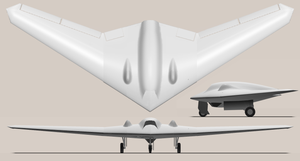BREAKING NEWS: Downed CIA Stealth Drone Marks Another Step Towards America’s War On Iran

The revelation that a US unmanned drone aircraft downed in eastern Iran was on a CIA secret surveillance operation raises troubling questions about the immediacy of Washington’s war plans on the Islamic Republic.
Initial reports of the lost drone at the weekend quoted US military officials claiming that the aircraft had strayed into Iranian territory while on a routine manoeuvre over Afghanistan as part of NATO’s occupation in that country.
However, now it emerges that the Unmanned Aerial Vehicle is a sophisticated surveillance model operated by the CIA, according to the Washington Post. Iran claims that its forces shot down the drone, and is now in its possession.
The CIA has declined to comment on why the RQ-170 Sentinel was in Iranian airspace. But the aircraft is known to possess state of the art surveillance equipment and is designed to evade radar detection. It is understand that this model of spy drone is used for “highly sensitive operations”.
It appears that the drone was deliberately being flown over Iranian territory and was not the usual type of spy plane that is used by NATO in neighbouring Afghanistan, nor was it simply off course by accident.
As the Washington Post reports: “The disclosure that the drone apparently recovered by Iran was being flown by the CIA comes after previous signals from US officials that had created the impression that the plane was being flown by the US military on a more mundane mission over Afghanistan and had simply strayed into Iranian territory.”
The newspaper adds: “The RQ-170 has special coatings and a batwing shape designed to help it penetrate other nations’ air defences undetected. The existence of the aircraft, which is made by Lockheed Martin, has been known since 2009, when a model was photographed at the main US airfield in Kandahar, Afghanistan.”
Clearly, the use of such advanced technology in Iranian airspace indicates a more than usual sinister purpose.
The disturbing implication is that such an infringement by US military of Iranian territory is tantamount to an act of war. It has to be placed in the context of months of ratcheting-up of war rhetoric from the Obama administration towards Iran, repeatedly asserting that all “options are on the table” in confronting the Islamic Republic over its alleged nuclear weapons programme. It is understood that this is a thinly veiled threat by the US and its Western allies to use pre-emptive military strikes against Iran. Israeli politicians have talked openly in recent months about pre-emptive air strikes against Iranian targets.
The belligerent rhetoric has accompanied equally aggressive moves by the US and Europe to choke Iran diplomatically, financially and economically – the latest move seeing Washington pressurising South Korea to cancel energy contracts with Iran. The stepping-up of sanctions by Britain against Iranian financial institutions and the subsequent diplomatic row over attacks by Iranian students on the British embassy in Tehran are also apiece with the building pretext for war.
Furthermore, the latest CIA drone infringement follows a spate of sabotage attacks on Iranian installations, including an explosion at a military base near Tehran on 12 November in which one of Iran’s top missile experts was killed. The involvement of Israel’s Mossad has been implicated in assassinations and kidnappings of other Iranian scientists. The US and Israel are also known to have carried out cyber attacks on Iranian military facilities over the past year.
The assiduous Western campaign to isolate and weaken Syria – Iran’s key ally in the region – can also be seen as an integral part of the long-held plans for an all-out military strike on Iran.
Despite the West’s best efforts to strangulate Iran, the country is believed to have developed formidable anti-aircraft and anti-missile defences. The CIA drone incursion into Iranian territory suggests that preparations are well underway to destroy such defences in advance of concerted air strikes against the Islamic Republic.
Finian Cunningham is Global Research’s Middle East and East Africa correspondent

